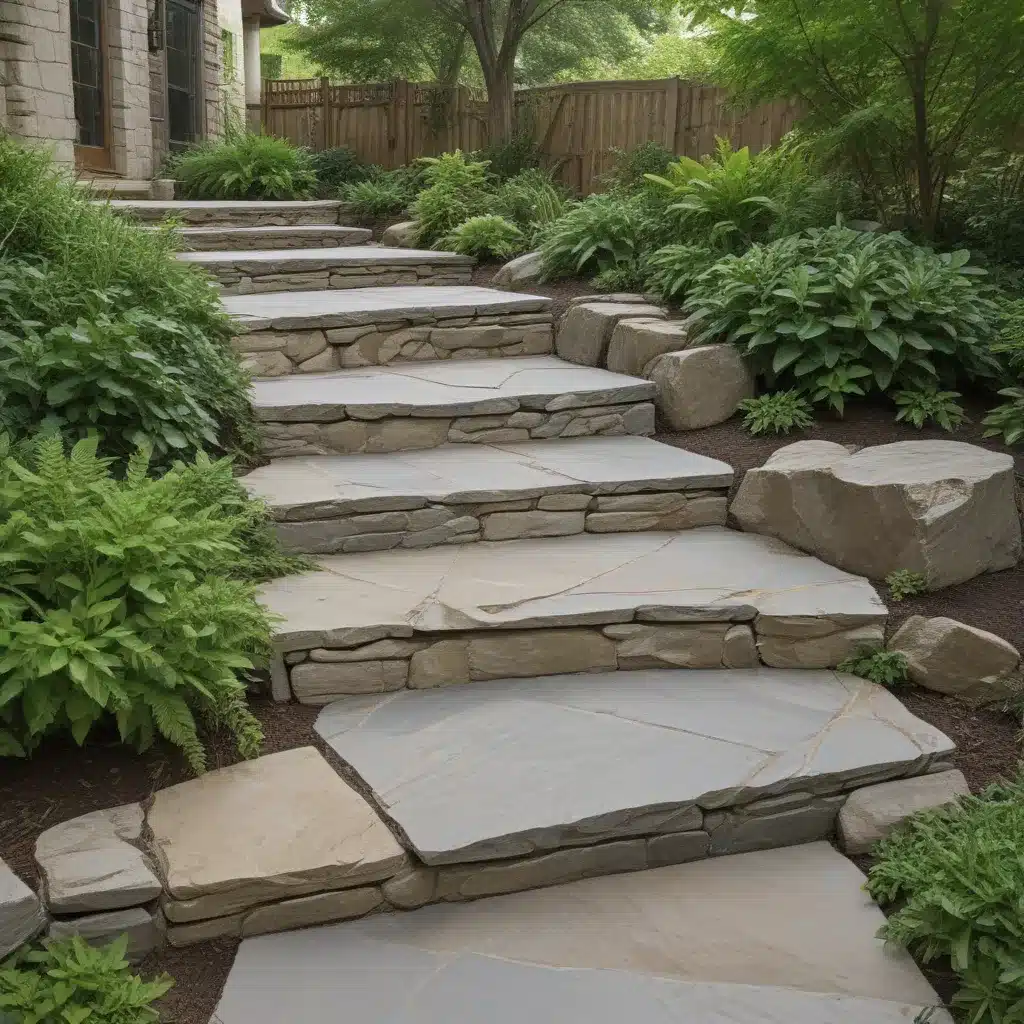Kicking Up a Storm: The Art of Building Sturdy Flagstone Stairs
As I learned from the U.S. Forest Service’s Trail Construction and Maintenance Notebook, the key to constructing a set of steps that will truly wow is to start from the bottom and work your way up. The most common mistake folks make is trying to tackle the project halfway up the slope – that’s a recipe for disaster, as the steps below will simply wash out.
So, when I’m tasked with building a set of flagstone stairs for one of our clients at A-1 Landscape Construction, I always make sure to excavate a solid footing at the bottom. This provides a sturdy foundation for the first step, which I then secure in place. Each successive step gets stacked on top or against the previous one, relying on the contact and friction to stay put.
Now, I know what you’re thinking – that sounds easy enough. But let me tell you, there’s an art to getting those steps to look just right. For one, the rise (height) and run (depth) need to be just right. Anything too steep or shallow and your clients will be tripping all over the place. I aim for a comfortable 6-8 inch rise and a nice, long run that can accommodate an entire foot. And don’t forget to armor the edges with some extra rocks – that encourages users to stay on the path and not go wandering off the sides.
Mastering the Riprap Stairway
But what if you’re working with a more rustic, natural setting, like a winding trail in the hills? Well, my friends, that’s where the riprap stairway shines. As the Forest Service notebook explains, this is a cross between cobblestones and formal steps, where the focus is on providing solid footing at each step rather than a uniform flight.
For these types of stairs, I like to use the largest, most rectangular rocks I can find and seat them as deeply as possible. If the stairs are traversing a slope, I’ll even excavate little footings to help hold that upper edge in place. And you better believe I’m kicking the heck out of every single step to make sure it’s as solid as a rock (pun intended).
Sometimes, I’ll even build a set of flagstone steps with a bit of mortar – though I have to say, I’m more of a dry stacker at heart. That mortar can come in handy for keeping everything locked in place, especially if the steps are going to see a lot of foot traffic. But you’ve got to be careful, because those freeze-thaw cycles can really wreak havoc on a mortared staircase.
Navigating the Width Conundrum
One thing the Forest Service notebook doesn’t really delve into is the ideal width for a set of stairs. As I’ve learned through my own experience, this is a bit of a tricky balance to strike.
You see, a lot of people think that wider is always better – that a grand, sweeping staircase will be the ultimate showstopper. But in my experience, anything over 4 feet tends to feel a bit too expansive for a residential backyard. It just doesn’t have that inviting, welcoming vibe that you want your clients to experience.
On the other hand, a narrow, steep set of stairs can feel downright intimidating. That’s why I like to err on the side of 3-4 feet wide – it’s just enough to feel spacious and grand, without being overwhelming. And if I really want to draw the eye in, I’ll play with the taper, making the steps narrower as they rise up the slope.
A Labor of Love (with a Kick Test)
Now, I know what you’re thinking – all this talk of excavating, seating, and kicking steps sounds like a whole lot of work. And you’d be absolutely right. Building a set of durable, showstopping flagstone stairs is no easy feat, I can assure you.
As the Forest Service notebook mentions, even with massive, rectangular rocks, I’m still kicking the heck out of every single step to make sure it’s rock-solid. And don’t even get me started on the intricate dance of lining up the risers and getting those stones to interlock just right. I once spent more time on a set of steps and a cheek wall than the entire rest of the project!
But you know what? When I see the look of pure delight on our clients’ faces as they ascend those stairs, it makes every aching muscle and bead of sweat worth it. These aren’t just functional pathways – they’re works of art that elevate the entire landscape. And that’s the kind of lasting impression I strive to leave with every project I take on at A-1 Landscape Construction.




